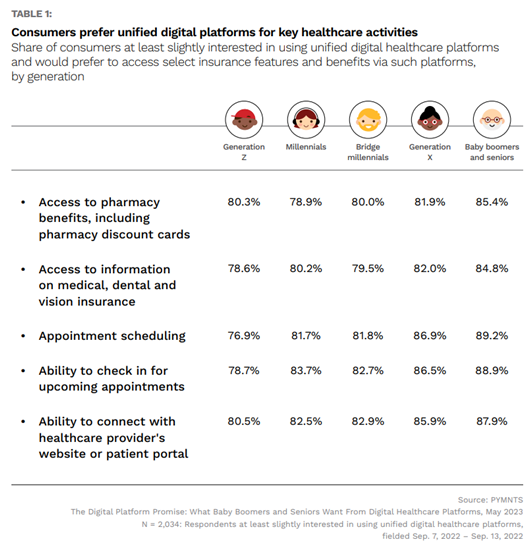Scaling Digital Healthcare Could Be Big Business as Consumers Seek Simplicity

Consumers are clamoring for a unified system to manage their health but nothing yet fits the bill.
Nearly every digital problem seems to have a variety of solutions in the ConnectedEconomy™. The fragmented healthcare system has not yet been solved, however, and a solution that would aid patients as they navigate the system is in demand. This is illustrated in the PYMNTS collaboration with Lynx, “The Digital Platform Promise: What Baby Boomers and Seniors Want From Digital Healthcare Platforms.”

Across age demographics, the lion’s share of surveyed consumers express at least a slight interest in accessing all selected features and benefits through a unified platform. Baby boomers and seniors, an oft-maligned group when it comes to technology, are particularly on board, demonstrating the most widespread interest in accessing features and benefits through digital healthcare platforms. The universal interest itself speaks to this consumer need.
No such product has been broadly brought to market, but some aspects of the healthcare journey that have historically frustrated patients are being addressed. Digital pay portals, for example, have gained broad acceptance, with 29% of surveyed consumers using the option in the past year.
As part of a larger retailer entry into healthcare, grocery giant Albertsons in February introduced Sincerely Health, a health and wellness platform. The tool allows users to link their healthcare wearables and activity trackers to the platform to log vital signs and integrate medication schedules. It also offers online pharmacy services and a telehealth portal to connect users with general practitioners.
While Sincerely Health may be the closest to a unified platform introduced so far, it still falls far short of what our data shows consumers demand.
In an interview with PYMNTS, Lynx’s head of partnerships, Tali Goldstein, details why the FinTech that successfully develops a unified healthcare platform may have a runaway winner on their hands.
“I think that consumers are really looking for this,” Goldstein said. “Those who have read through the report will have seen that consumers know this is something missing in their healthcare journeys. They know that a unified platform could theoretically step in to help them manage [many] aspects of their care journey and their family’s care journey. … [A unified platform] can not only educate on what the best next step is in that journey, but even start to guide and say, this is the service I would use now, and this is how I would pay for that service.”
While launching any successful unified healthcare platform would be a massive undertaking, the potential broad adoption of such a product may be tantalizing for potential providers. After all, consumers’ clamor for a solution means that the rewards could far outweigh the risks for the first provider to crack the code.

